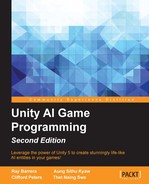Book Description
Leverage the power of Unity 5 to create fun and unbelievable AI entities in your games!
About This Book
- Compose richer games by learning the essential concepts in artificial intelligence with exciting examples
- Explore the brand new Unity 5 features that make implementing artificial intelligence in your game easier than ever
- Using this practical guide become a competent Unity 3D developer by learning AI techniques, methods and the applicability of AI
Who This Book Is For
This book is intended for Unity developers with a basic understanding of C# and the Unity editor. Whether you’re looking to build your first game or are looking to expand your knowledge as a game programmer, you will find plenty of exciting information and examples of game AI in terms of concepts and implementation. It does not require any prior technical knowledge of how game AI works.
What You Will Learn
- Understand the basic terminology and concepts in game AI
- Implement a basic finite state machine using state machine behaviors in Unity 5
- Create sensory systems for your AI with the most commonly used techniques
- Implement an industry-standard path-finding system and a navigation mesh with the Unity 5 NavMesh feature
- Build believable and highly-efficient artificial flocks and crowds
- Create a basic behavior tree to drive a character’s actions
- Make your characters more engaging by implementing fuzzy logic concepts in your AI’s decision-making
- Tie all the concepts together with examples and guides
In Detail
Unity 5 provides game and app developers with a variety of tools to implement artificial intelligence. Leveraging these tools via Unity’s API or built-in features allows limitless possibilities when it comes to creating your game’s worlds and characters. Whether you are developing traditional, serious, educational, or any other kind of game, understanding how to apply artificial intelligence can take the fun-factor to the next level!
This book helps you break down artificial intelligence into simple concepts to give the reader a fundamental understanding of the topic to build upon. Using a variety of examples, the book then takes those concepts and walks you through actual implementations designed to highlight key concepts, and features related to game AI in Unity 5. Along the way, several tips and tricks are included to make the development of your own AI easier and more efficient.
Starting from covering the basic essential concepts to form a base for the later chapters in the book, you will learn to distinguish the state machine pattern along with implementing your own. This will be followed by learning how to implement a basic sensory system for your AI agent and coupling it with a finite state machine (FSM). Next you will be taught how to use Unity’s built-in NavMesh feature and implement your own A* pathfinding system. Then you will learn how to implement simple flocks and crowd’s dynamics, the key AI concepts. Then moving on you will learn how a behavior tree works and its implementation. Next you will learn adding layer of realism by combining fuzzy logic concepts with state machines. Lastly, you learn applying all the concepts in the book by combining them in a simple tank game.
Style and approach
An easy-to-follow guide that is full of example implementations of the concepts and is accompanied by easy-to-understand demonstrations and explanations of the code and concepts.
Downloading the example code for this book. You can download the example code files for all Packt books you have purchased from your account at http://www.PacktPub.com. If you purchased this book elsewhere, you can visit http://www.PacktPub.com/support and register to have the code file.
Table of Contents
- Unity AI Game Programming Second Edition
- Table of Contents
- Unity AI Game Programming Second Edition
- Credits
- About the Authors
- About the Reviewers
- www.PacktPub.com
- Preface
- 1. The Basics of AI in Games
- 2. Finite State Machines and You
- 3. Implementing Sensors
- 4. Finding Your Way
- 5. Flocks and Crowds
- 6. Behavior Trees
- 7. Using Fuzzy Logic to Make Your AI Seem Alive
- 8. How It All Comes Together
- Index
